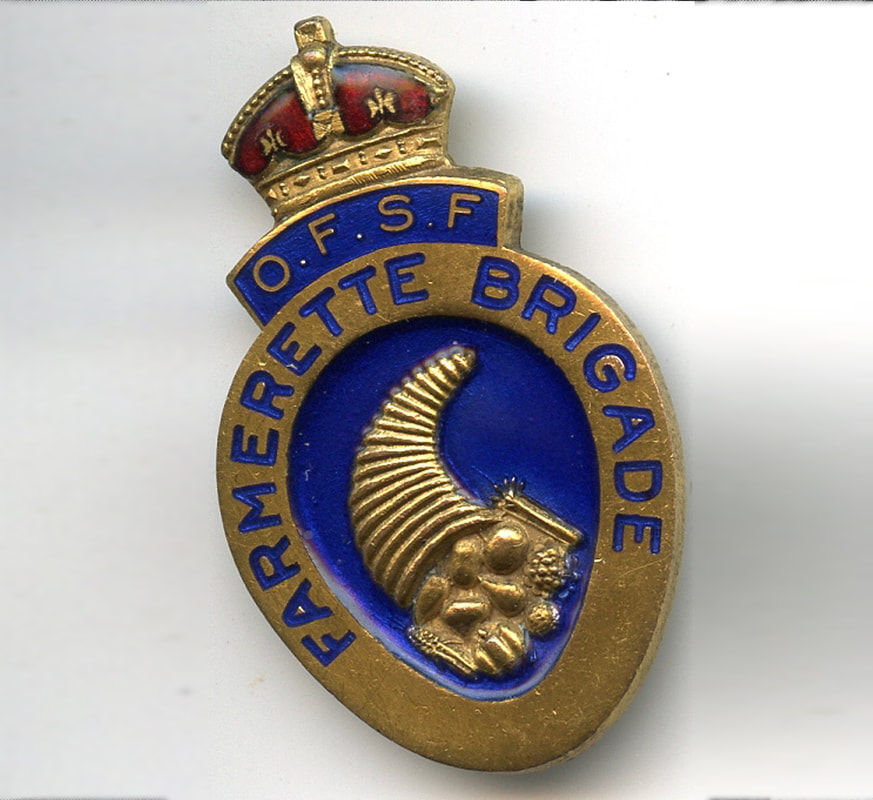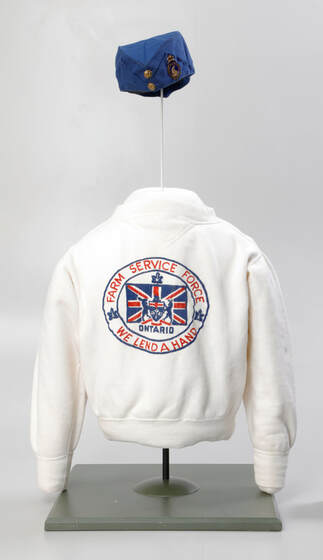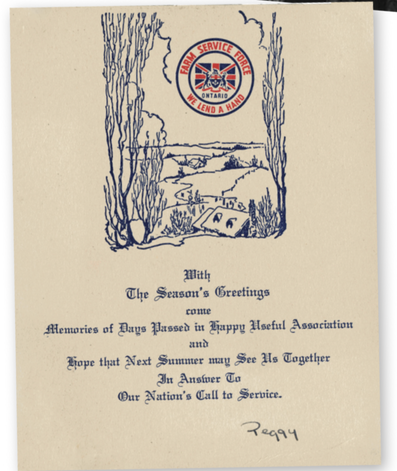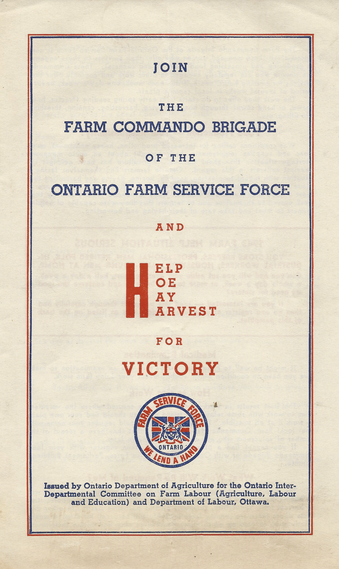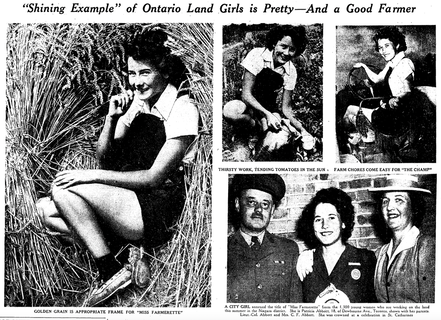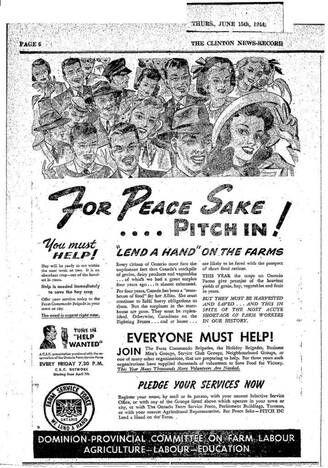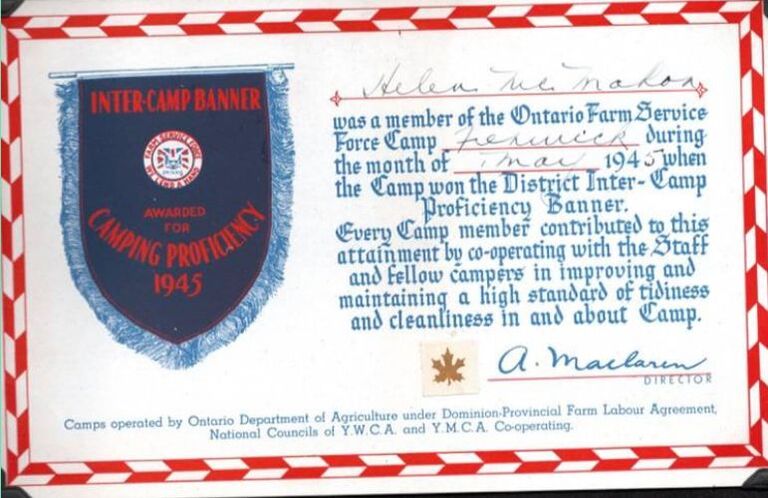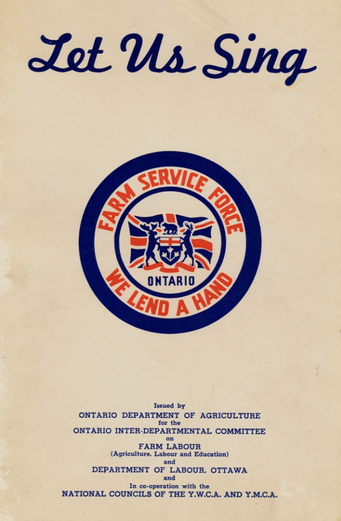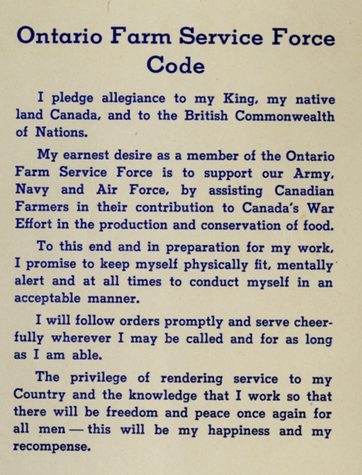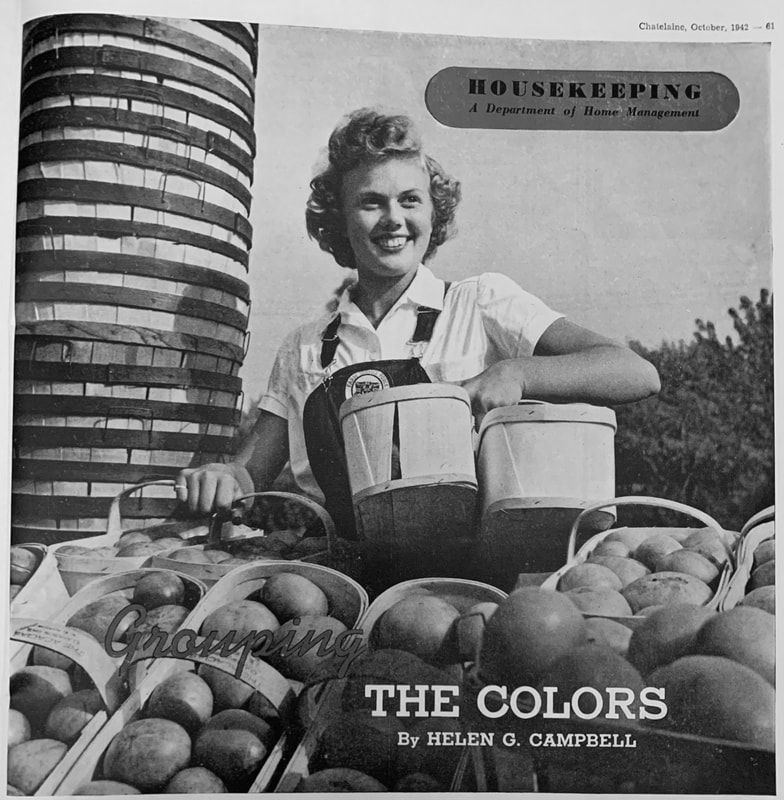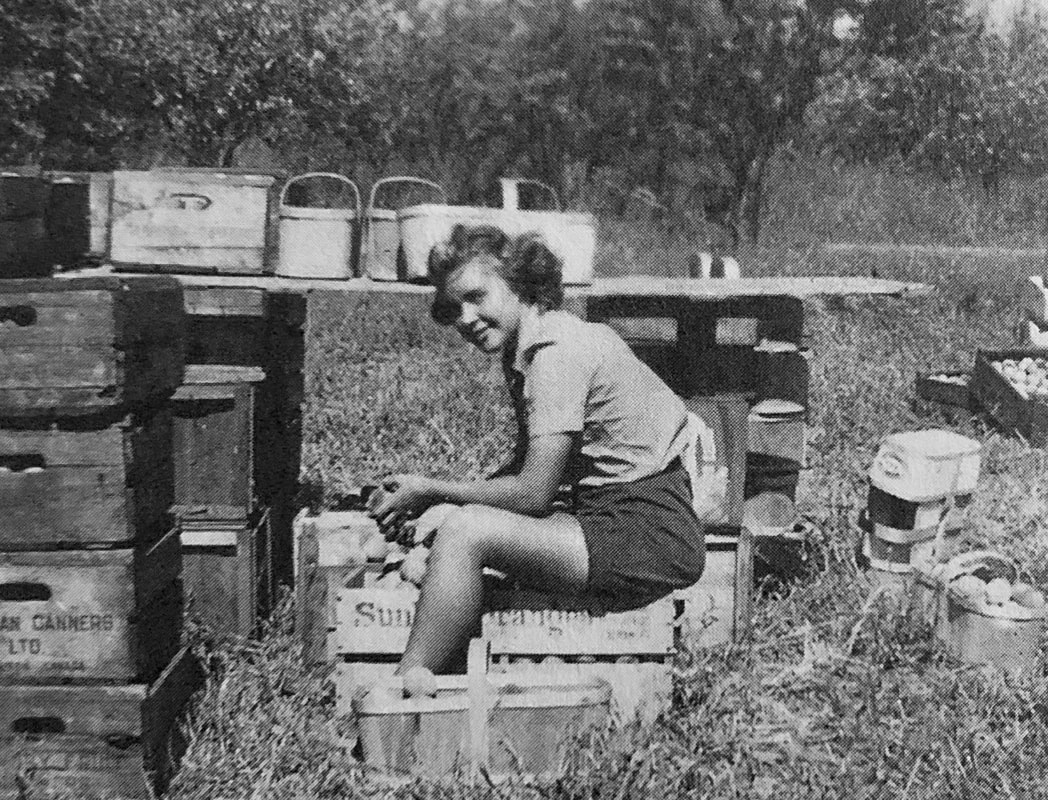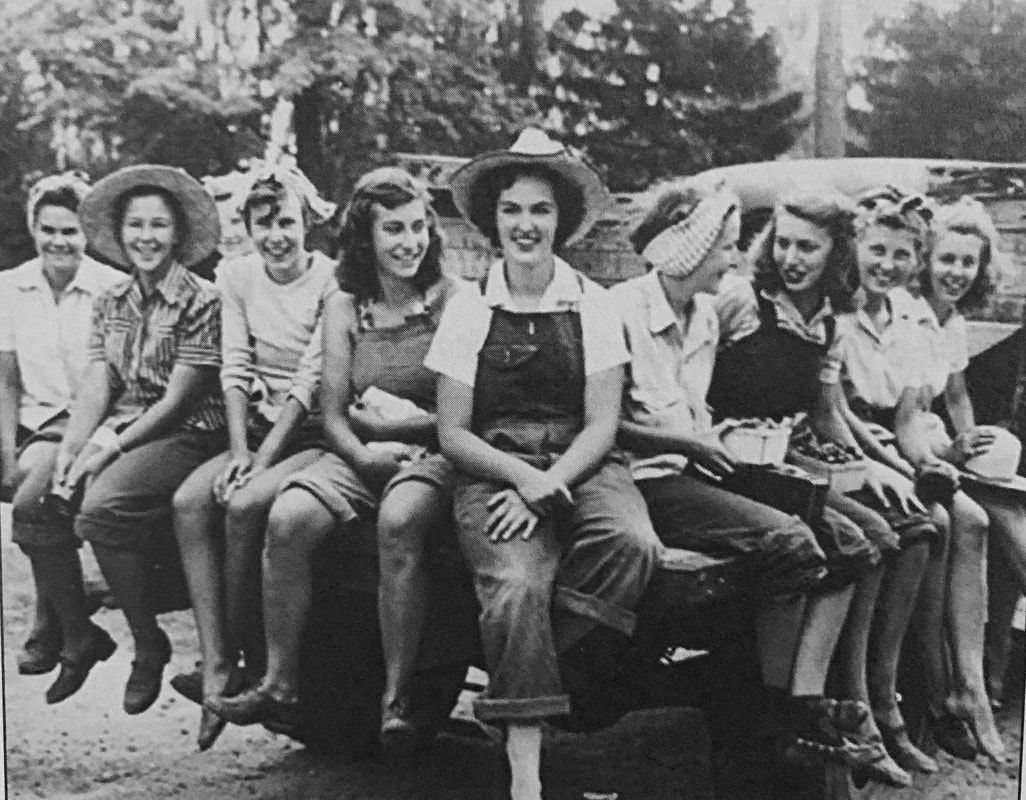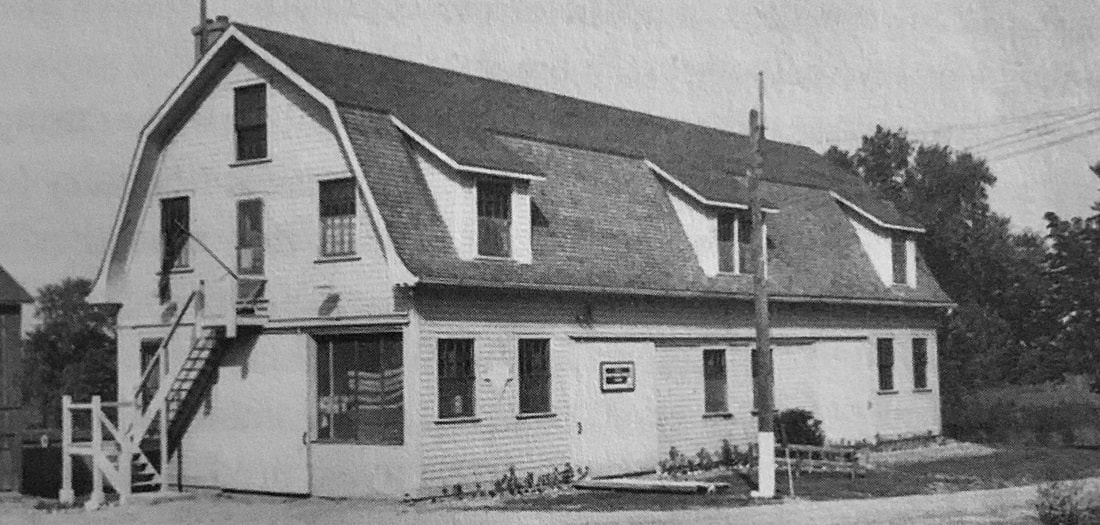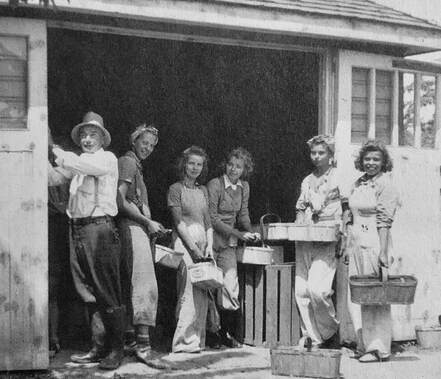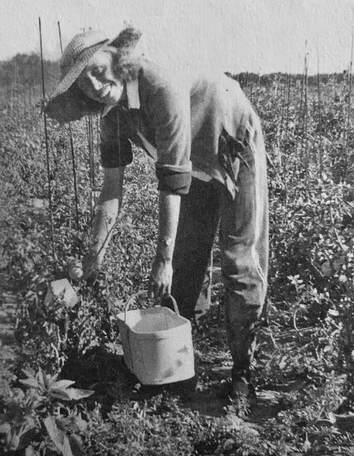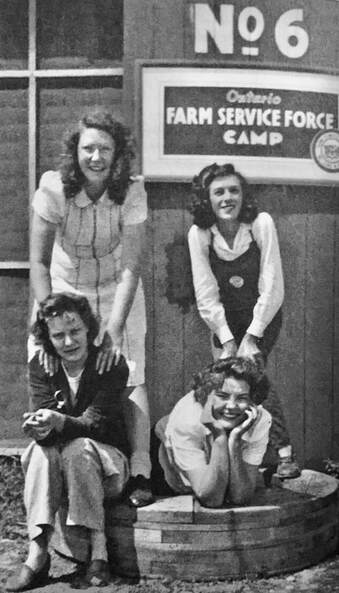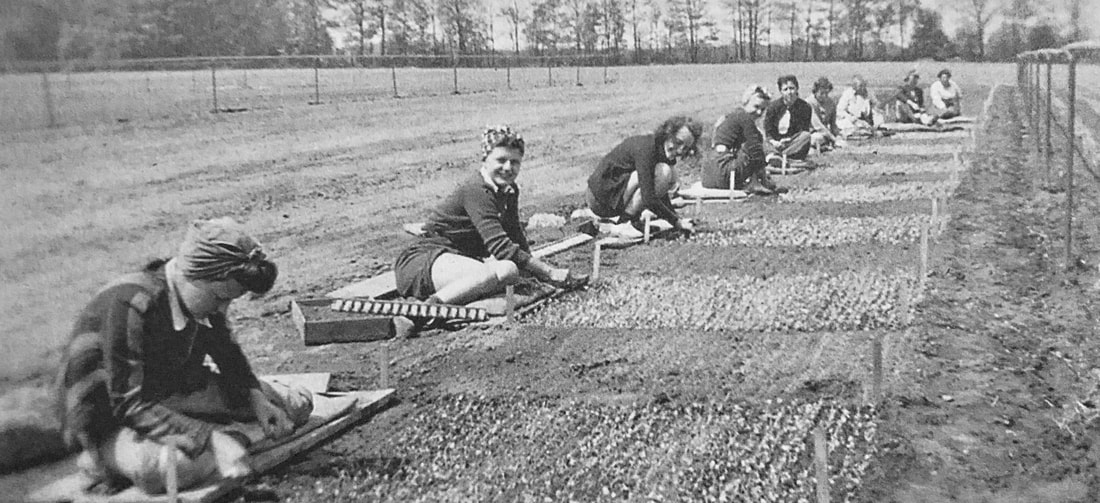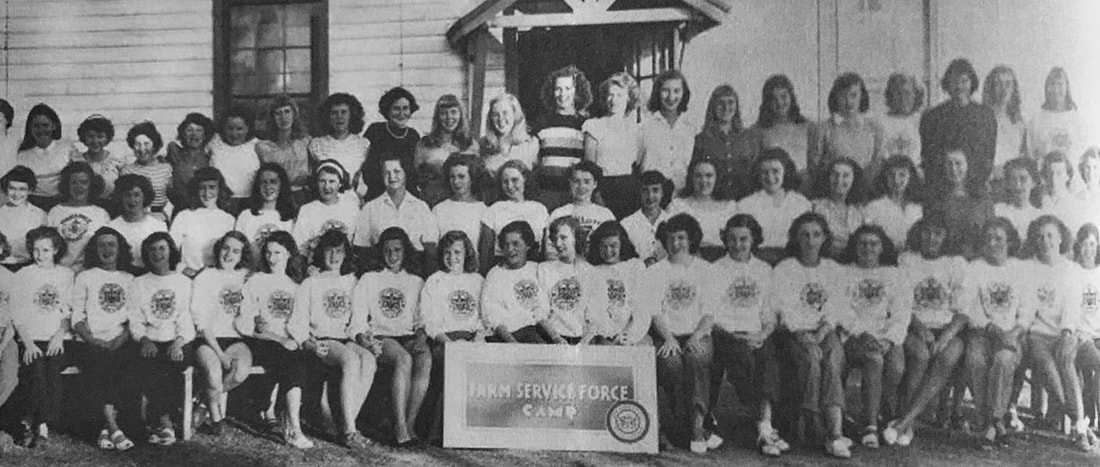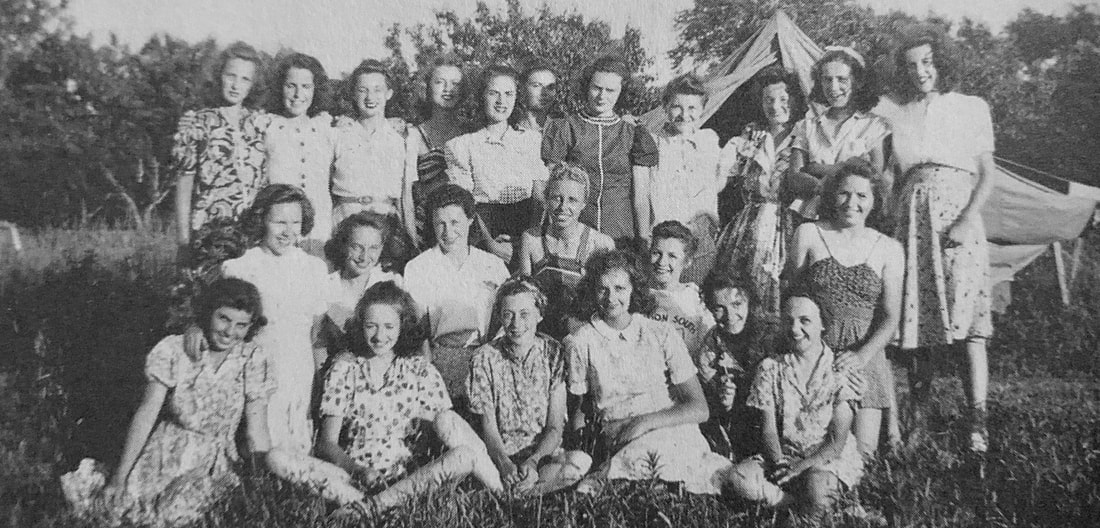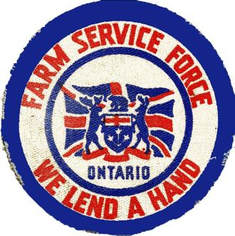 Farmerette Badge, Courtesy of Bonnie Sitter
Farmerette Badge, Courtesy of Bonnie Sitter
Badge.
The Ontario Farm Service Force (OFSF) insignia was chosen in 1941. It was circular shaped, edged in blue, with the words with "Farm Service Force" and "We Lend a Hand" written in red. The Ontario flag was centred in the middle.
The Ontario Farm Service Force (OFSF) insignia was chosen in 1941. It was circular shaped, edged in blue, with the words with "Farm Service Force" and "We Lend a Hand" written in red. The Ontario flag was centred in the middle.
|
Uniform.
Only the badge was required as a "uniform" and many girls simply sewed the badge to their regular work clothing. However, a uniform could be purchased at the cost of the individual. Girls could buy a cap, pin, and dress of navy blue, and even a sweatshirt was available for purchase. |
Girls, We Need You Again!
Agricultural labour shortages appeared again soon after Canada entered the Second World War in September 1939. The Ontario Department of Labour reached out to the Y.W.C.A. in 1941, hoping to re-instate the Land Army camps for women and girls that had been operational during the First World War. The Y.W.C.A. was interested, but did not have the money in their war services budget. After some negotiations, (the name "Land Army" was changed to "Farm Service Force," an insignia was designed, and it was agreed that camps would be funded by the government rather than by the Y.W.C.A.'s war services budget) the first camp for women farm workers opened in St. Catherines, Ontario on 16 May 1941.
In July, 9 more camps had opened with an average of sixty girls living at each location. The Y.W.C.A. locations at Hamilton, Niagara Falls, and St. Catherines provided entertainment for the girls. By the end of the 1941 season, ten government-run camps for girls with a staff of 70, hosted 1,121 girls.
By 1942, the Y.W.C.A. knew that this program was going to be much too large for them to handle, and it soon became the responsibility of the Provincial and Federal Departments of Agriculture. The provincial government recruited the girls, handled relations with farmers, and took over all financial responsibility. In turn, the federal government covered 50% of the operating budget. Camps continued to be staffed by the Y.W.C.A., who took care of the girls' nutrition, health, recreation, and proper supervision. The Government and the Y.W.C.A. chose camp sites together, and girls lived in Nissan huts, farm houses, tents, schoolhouses, converted barns or garages, and old motels.
Recruitment tactics for the OFSF were strong; field staff visited schools, advertisements were placed in newspapers, and the Niagara district even held a "Miss Farmerette" pageant. To encourage enlistment, the girls who enlisted were able to end their school term early, in mid-May, without writing exams. Camp numbers tripled and more than 3,000 girls were recruited in 1942.
Women and girls participated in many agricultural tasks:
Each day, the Farmerettes were picked up by farmers who transported them to nearby fields. While much of the work was repetitive and tiresome, the Y.W.C.A. organized recreational activities, beach parties, talent shows, and weekly dances to boost morale in the camps. On their days off, the girls were encouraged to hitchhike to Toronto, Niagara Falls, or Buffalo, N.Y. The Harvester, a newsletter published by the O.F.S.F., circulated stories, camp songs, and a schedule of upcoming events, and the province of Ontario even paid tribute to the girls with “Farmerette Recognition Day.”
1944 was the OFSF's peak year, operating 51 camps and a total of 3,760 girls. However, the program was so successful that it remained in operation until 1952, and many of the girls returned each summer to participate.
In July, 9 more camps had opened with an average of sixty girls living at each location. The Y.W.C.A. locations at Hamilton, Niagara Falls, and St. Catherines provided entertainment for the girls. By the end of the 1941 season, ten government-run camps for girls with a staff of 70, hosted 1,121 girls.
By 1942, the Y.W.C.A. knew that this program was going to be much too large for them to handle, and it soon became the responsibility of the Provincial and Federal Departments of Agriculture. The provincial government recruited the girls, handled relations with farmers, and took over all financial responsibility. In turn, the federal government covered 50% of the operating budget. Camps continued to be staffed by the Y.W.C.A., who took care of the girls' nutrition, health, recreation, and proper supervision. The Government and the Y.W.C.A. chose camp sites together, and girls lived in Nissan huts, farm houses, tents, schoolhouses, converted barns or garages, and old motels.
Recruitment tactics for the OFSF were strong; field staff visited schools, advertisements were placed in newspapers, and the Niagara district even held a "Miss Farmerette" pageant. To encourage enlistment, the girls who enlisted were able to end their school term early, in mid-May, without writing exams. Camp numbers tripled and more than 3,000 girls were recruited in 1942.
Women and girls participated in many agricultural tasks:
- planting, weeding, hoeing in the fields
- picking, thinning, pruning, and packing fruits and vegetables
- grading eggs
- milking cows
- driving tractor
- caring for chickens and turkeys
Each day, the Farmerettes were picked up by farmers who transported them to nearby fields. While much of the work was repetitive and tiresome, the Y.W.C.A. organized recreational activities, beach parties, talent shows, and weekly dances to boost morale in the camps. On their days off, the girls were encouraged to hitchhike to Toronto, Niagara Falls, or Buffalo, N.Y. The Harvester, a newsletter published by the O.F.S.F., circulated stories, camp songs, and a schedule of upcoming events, and the province of Ontario even paid tribute to the girls with “Farmerette Recognition Day.”
1944 was the OFSF's peak year, operating 51 camps and a total of 3,760 girls. However, the program was so successful that it remained in operation until 1952, and many of the girls returned each summer to participate.
|
|
|
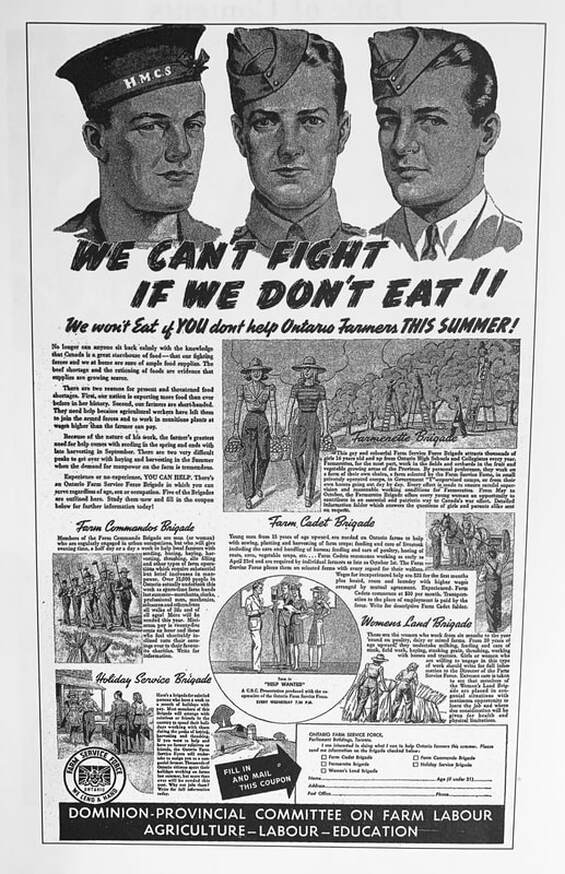 English and Sitter, "Onion Skins and Peach Fuzz: Memories of Ontario's Farmerettes" (Self Published, Friesen’s Corporation, 2019) pg. VIII.
English and Sitter, "Onion Skins and Peach Fuzz: Memories of Ontario's Farmerettes" (Self Published, Friesen’s Corporation, 2019) pg. VIII.
The Ontario Farm Service Force actually acted as an umbrella organization, under which five different Brigades operated. They are listed in this Dominion-Provincial Committee on Farm Labour advertisement:
1. The Farm Commandos Brigade for city men and women who wished to offer an evening or weekend to help local farmers
2. The Holiday Service Brigade who wished to spend their holidays working on a farm
3. The Farmerette Brigade (the OFSF's most popular choice) for girls aged 16 and up from high schools and colleges. The girls lived in camps from May to October.
4. The Farm Cadet Brigade for boys aged 15 and up, placed on a farm to work between the months of April and October.
5. The Women's Land Brigade for women aged 20 years and older who wished to work on a poultry, dairy, or mixed farm for six months of the year.
Two other Brigades, The Children's Brigade, which employed children aged 12 and up to work on their own farm, or the farm of a neighbour, and The Farm Girls Brigade, for young farm women aged 26 and up who helped with farm operations, was also instated, but not mentioned in this article.
1. The Farm Commandos Brigade for city men and women who wished to offer an evening or weekend to help local farmers
2. The Holiday Service Brigade who wished to spend their holidays working on a farm
3. The Farmerette Brigade (the OFSF's most popular choice) for girls aged 16 and up from high schools and colleges. The girls lived in camps from May to October.
4. The Farm Cadet Brigade for boys aged 15 and up, placed on a farm to work between the months of April and October.
5. The Women's Land Brigade for women aged 20 years and older who wished to work on a poultry, dairy, or mixed farm for six months of the year.
Two other Brigades, The Children's Brigade, which employed children aged 12 and up to work on their own farm, or the farm of a neighbour, and The Farm Girls Brigade, for young farm women aged 26 and up who helped with farm operations, was also instated, but not mentioned in this article.
|
|
Sources:
English, Shirleyan, and Bonnie Sitter. Onion Skins and Peach Fuzz: Memories of Ontario Farmerettes. Self Published, Friesen’s Corporation, 2019.
Hanlon, Sheila. “Fair Soldiers of the Soil: Expressions of Gender Ideology Within the Women’s Division of the Ontario Farm Service Force.” Masters Thesis, University of Guelph, 2002.
Harshaw, Josephine Perfect. When Women Work Together: A History of The Young Women’s Christian Association in Canada. Canada: Ryerson Press, 1966.
Innis, Mary Quayle. Unfold the Years: A History of The Young Women’s Christian Association in Canada. Toronto: McClelland & Stewart Ltd., 1949.
English, Shirleyan, and Bonnie Sitter. Onion Skins and Peach Fuzz: Memories of Ontario Farmerettes. Self Published, Friesen’s Corporation, 2019.
Hanlon, Sheila. “Fair Soldiers of the Soil: Expressions of Gender Ideology Within the Women’s Division of the Ontario Farm Service Force.” Masters Thesis, University of Guelph, 2002.
Harshaw, Josephine Perfect. When Women Work Together: A History of The Young Women’s Christian Association in Canada. Canada: Ryerson Press, 1966.
Innis, Mary Quayle. Unfold the Years: A History of The Young Women’s Christian Association in Canada. Toronto: McClelland & Stewart Ltd., 1949.

